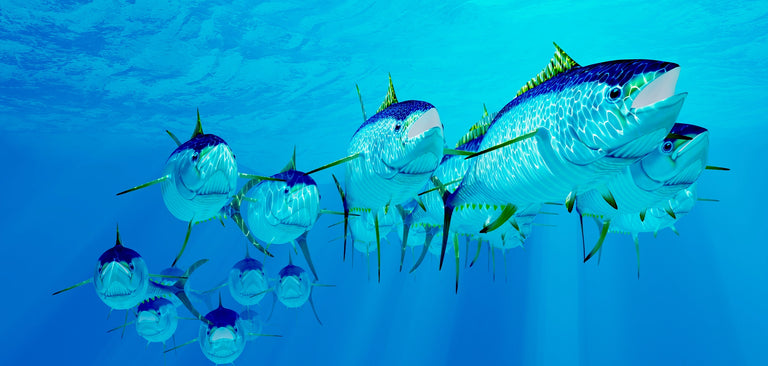Did you know that in the U.S., we consume approximately 1 billion pounds of canned and pouched tuna annually, with only coffee and sugar being more popular in terms of items sold per shelf space in groceries? Did you also know that our ocean provides various tuna species, and that we usually only see a couple on retail shelves?

With such high U.S. tuna consumption, the likelihood is that you have tried some yourself. However, how much do you know about tuna? In this article, we’ll share a bit more about the different species of tuna, where they live in our oceans as well as why it’s imperative that we pursue sustainable fishing methods. You’ll also find some of our new favorite tuna recipes.
How many species of tuna are there?
There are fifteen species of tuna. However, the species that are most commonly found on grocery shelves are albacore (known as white tuna) and skipjack (often known as light tuna). Yellowfin and bigeye are also found on shelf, though not as frequently as albacore and skipjack. Below are highlights of eight species – those found on grocery shelves as well as bluefin and frigate tuna.
Common & Scientific Name |
Maximum Size & Weight |
Maximum Lifespan |
Flavor |
|
 |
Albacore Thunnus alalunga |
3.9 feet |
13 years |
Mild to medium flavor profile with firm, meaty flesh and large flakes |
 |
Skipjack Katsuwonus pelamis |
3.6 feet 76 lbs |
6-8 years | Relatively tender texture and rich fish flavor |
 |
Yellowfin Thunnus albacares |
7.8 feet 388 lbs |
4-8 years | Medium-mild flavor with very firm texture |
 |
Bigeye Thunnus obesus |
8.2 feet 462 lbs |
5-16 years | Moderately pronounced flavor, a high fat content and rich flavor; texture is firm and meaty with large flakes |
 |
Atlantic Bluefin Thunnus thynnus |
15 feet 1,496 lbs |
25 years | Dark and fatty flesh with distinctive medium-full flavor and firm, meaty texture with large flakes |
 |
Pacific Bluefin Thunnus orientalis |
9.8 feet 992 lbs |
26 years | Dark and fatty flesh with distinctive medium-full flavor and firm, meaty texture with large flakes |
 |
Southern Bluefin Thunnus maccoyii |
7.3 feet 440 lbs |
20-40 years | Dark and fatty flesh with distinctive medium-full flavor and firm, meaty texture with large flakes |
 |
Frigate Auxis thazard |
1.6 feet 4 lbs |
4 years | Oily flesh |
Where do tuna live?
Tuna are found throughout our oceans. Below are where the eight species we’re discussing make their homes:
Albacore tuna
Skipjack tuna
Yellowfin tuna
Bigeye tuna
Bluefin tuna
- Atlantic Bluefin are the largest of the bluefin tuna species. It can be found in subtropical and temperate waters of the Atlantic Ocean and the Mediterranean and occasionally in the Black Seas.
- Pacific Bluefin is slightly smaller than Atlantic Bluefin but still large. It can be found from the Gulf of Alaska to Baja California in the East and from Sakhalin Island to New Zealand in the West.
- Southern Bluefin also reach large sizes like the other bluefin. They can be found in the Southern Hemisphere of the Atlantic, Indian and Pacific oceans.
Frigate tuna
What fishing method is used to catch tuna?
There are multiple fishing methods used to catch tuna, however, not all of them are equal. At Wild Planet, we selectively harvest our tuna using 100% sustainable pole & line, troll, or handline caught fishing methods – nets are never used. By fishing in this way, we virtually eliminate bycatch – species unintentionally caught in the process of fishing a targeted catch. Sustainable fishing gives tuna, and all sea life, a chance to repopulate naturally. This keeps our wild oceans diverse and healthy.
Below are a few sustainable methods used by Wild Planet along with several wasteful methods which we never use, but ones which you may hear discussed by fishing and sustainability organizations around the world.
Sustainable methods
- Pole & Line / Handline: Practiced for centuries, pole & line fishing catches tuna from a bait boat. Live sardines and anchovies are thrown overboard attracting schools of tuna creating a feeding frenzy. Using a pole & line, fishermen catch and haul younger, migratory tuna onto the boat one-by-one.
- Trolling: This sustainable fishing method involves towing artificial lures (also known as jigs) behind a slow-moving boat. When fishing for tuna, vessels rig their boats with approximately 10 to 20 fishing lines. Each is attached with a barbless jig that appeals to the targeted species.
Wasteful methods
- Purse Seines with the use of FADs: FADs (Fish Aggregating Devices) are radio-beaconed floating devices that attract all types of fish beyond a targeted species. Small fish and tiny tuna aggregate to the cover of the FAD. These smaller fish then attract larger fish, which lures in even more species like sharks and turtles. These are caught along with the tuna and many are discarded. Catching tiny juvenile tuna results in lost food supply, while bycatch mortality disrupts the ocean’s natural balance and threatens local communities’ food security.
- Long-Line Fishing: The most common method used to catch albacore worldwide, long-line fishing uses long lines that attract a variety of ocean species beyond tuna. Endangered sea turtles, sharks and other fish also bite the bait creating wasteful bycatch mortality and an unbalanced ocean ecosystem.
What type of tuna is best?
The U.S. Food and Drug Administration recommends making fish a regular part of your diet. All tuna have incredible health benefits. This includes protein, vitamin D, vitamin B12, calcium, and EPA and DHA omega-3 fatty acids.
- Protein: Necessary to build strong and healthy bones, muscles, cartilage, and skin.
- Vitamin D: This vitamin is critical for ensuring bone health and supports the immune system.
- Vitamin B12: This vitamin is essential for red blood cells, nerve function, and the production of DNA.
- Calcium: This mineral plays an important role in building and maintaining strong bones, as well as a healthy heart, muscles, and nerves.
- EPA and DHA omega-3s: These fatty acids reduce inflammation and improve overall blood flow.
How can tuna be prepared?
You will frequently find tuna sold as tinned fish in grocery stores. Research shows that one in four American consumers serve tuna once or more a week. While tinned fish can usually be eaten as-is, here are some of our tried and true tuna recipes for albacore and skipjack, two of the 100% sustainably caught species which Wild Planet offers.
Buffalo Tuna Twice Baked Potatoes
These baked potatoes featuring Wild Planet tuna make a great snack or tasty dinner loaded with cheese, sour cream, Buffalo sauce and freshly diced tomatoes and onion.

Mediterranean Tuna Salad Boats
Looking for easy meal prep? Try these delicious bell peppers filled with flavorful tuna salad, tomatoes, Kalamata olives, cucumbers and Feta cheese. This recipe may quickly become a new staple in your home.

Tuna Mousse on Crispy Potatoes
This tuna mousse is made with ricotta cheese and topped with bacon, parmesan and fresh thyme. Try serving on roasted sweet potatoes or your favorite crusty bread to switch things up.

Open Face Lemony Tuna Melt
If you’ve never had a tuna melt, let this recipe be your first of many. It contains mouth-watering pieces of tuna complemented with zesty lemon, vine-ripened tomatoes, Monterey Jack (or provolone) cheese and a hint of red pepper flakes. You can thank us later.

Ready to choose your next tuna?
We hope the information here makes shopping for and planning tuna meals that much easier. We know how important it is to feel comfortable and confident about the food in your pantry and on your table. If you want to know more about sustainable seafood and sustainable fishing, please visit our sustainability page. Together, we can make a positive impact in our world now and for future generations.
Sources:
- https://aboutseafood.com/tuna-council-3/tuna-facts/
- https://www.iss-foundation.org/tuna-stocks-and-management/tuna-fishing/tuna-species/
- https://fishider.org/en
- https://www.marinebio.org/search
- https://www.chefs-resources.com/seafood/finfish/tuna-varieties/
- https://atuna.com/pages/tuna-species-guide#species
- https://www.montereybayaquarium.org/animals/animals-a-to-z/
- https://genomics.senescence.info/species/entry.php?species=Auxis_thazard
- https://biogeodb.stri.si.edu/caribbean/en/thefishes/species/4256#
- https://fishesofaustralia.net.au/home/species/718
- https://www.webmd.com/diet/health-benefits-tuna#







